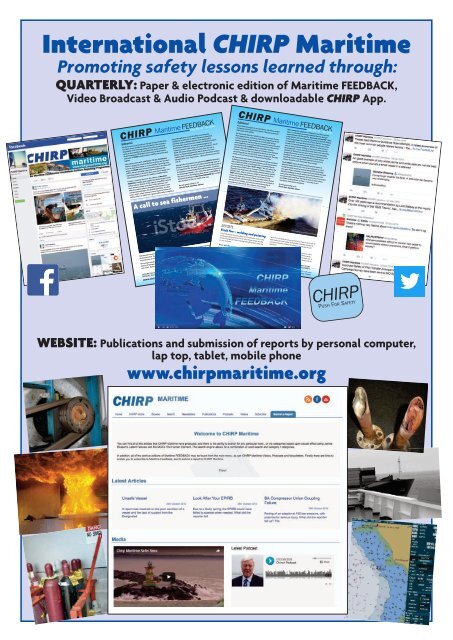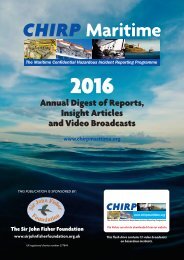CHIRP annual digest 2016 6th
You also want an ePaper? Increase the reach of your titles
YUMPU automatically turns print PDFs into web optimized ePapers that Google loves.
International <strong>CHIRP</strong> Maritime<br />
Promoting safety lessons learned through:<br />
QUARTERLY: Paper & electronic edition of Maritime FEEDBACK,<br />
Video Broadcast & Audio Podcast & downloadable <strong>CHIRP</strong> App.<br />
<strong>CHIRP</strong> Maritime FEEDBACK<br />
Editorial<br />
Issue No: 43 02/<strong>2016</strong><br />
We have received a varied and rich set of reports this time. sense throughout a vessel of safety consciousness,<br />
For these, many thanks to our contributors who include a confidence at al levels to report lapses, professional<br />
ship Master with a strong safety sense who occasionally alertness, and a ruthless ‘mend it now’ approach to<br />
sends us short outlines of cases he notes on his rounds (no shortcomings. If corrosion has rendered a lifeboat release<br />
doubt keeping his Chief Mate on his toes in the process), mechanism ineffective, it is not good enough to say<br />
and some of <strong>CHIRP</strong>’sambassadors in different sectors and “tomorrow; next week; when we’re next in harbour”. FIX IT<br />
regions.<br />
NOW. Of course safety culture comes from the top; a<br />
Master or Superintendant only has to been seen once<br />
This edition starts with A MESSAGE TO SEA FISHERMEN.<br />
walking past something which is not as it should be without<br />
Theirs is dangerous work at the best of times; but we don’t<br />
taking action, and – hey presto – that’s what everyone else<br />
hear as much from them as we would like. Reporting near<br />
will do.<br />
misses to <strong>CHIRP</strong>does not need to take long. A few lines will<br />
suffice. We are working in parallel to modernise the<br />
Amongst the innovations introduced by <strong>CHIRP</strong>’sMaritime<br />
reporting system so it can be done even more simply and Director recently is a series of videos which bring some of<br />
interactively at the press of a mobile or tablet button.<br />
our reports to life. The next video will include the results of<br />
a simulation conducted by Warsash Maritime Academy –<br />
Is there a common theme in this edition of Maritime<br />
to whom huge thanks – of a very close quarters situation at<br />
FEEDBACK? I might again emphasise the hardy perennial:<br />
the entrance to the NE-going deep water route (DWR) at<br />
safety culture. Almost all the reports we publish concern<br />
Sandettie (published in Maritime FEEDBACK 42). It will bring<br />
near-misses; in some cases they reflect positive and<br />
the situation to life in a wholly new way.<br />
effective safety cultures through which incidents were<br />
averted onboard ships. We should laud these. In other<br />
Be safe; good sailing to all.<br />
cases, where safety measures have lapsed, a failure of<br />
Charles Style, Maritime Advisor<br />
safety culture is indicated. A good safety culture implies a<br />
A call to sea fishermen …<br />
<strong>CHIRP</strong> Maritime FEEDBACK<br />
Editorial<br />
Many thanks once again to our contributors who have provided<br />
enormously valuable and varied reports. They give us plenty to<br />
think about in this edition.<br />
Our themes this time start with fire in ships: one a major fire on a<br />
ship’s superstructure, reminds us of the crucial importance of ‘hot<br />
work’ procedures. These principles do not only apply to large<br />
vessels; a separate and harrowing case concerns a catamaran yacht<br />
which caught fire at sea, and was ablaze in moments. This was not<br />
reported formally to <strong>CHIRP</strong>; however it provides a salutary<br />
reminder that safety principles apply to all classes, sizes and types<br />
of vessel. In this case the crew jumped for their lives, and were<br />
rescued from the sea; but their home went to the bottom. The other<br />
article on fire risk concerns the hardy perennial of galleys.<br />
We then consider more reports with the theme of collision avoidance<br />
including one involving an encounter between a yacht and merchant<br />
ship at night; this offers us much insight. We are reminded that at<br />
sea, and especially on bridges “doubt = danger”. We also address the<br />
growing misuse of VHF radio to “arrange” collision avoidance, and<br />
the proper use of Electronic Chart Display and Information Systems<br />
(ECDIS) in ships. Then we come to a number of reports (many from<br />
<strong>CHIRP</strong> ambassadors) which remind us of crucial and recurring<br />
lessons; top dead centre in many of these are safety culture, human<br />
factors generally, electrical safety, the maintenance of standards at<br />
the time of crew changes, and awareness and understanding of<br />
procedures (in other words, the avoidance of box ticking).<br />
Issue No: 44 09/<strong>2016</strong><br />
Where emergency equipment – designed to save life or prevent<br />
injury – is concerned, we are also reminded that we don’t get<br />
second chances with that which is “least used, most needed”. When<br />
a ship founders, this is not the moment to discover that the lifeboat<br />
cannot be launched or lowered. We all know that the “sea endures<br />
no makeshifts”. As we go about our business, almost every action<br />
we take is to do with minimising risk. We hold on, when in heavy<br />
seas; we wear protective clothing; we are unconsciously alert for<br />
the unexpected – a noise, movement, smell, heat, water where they<br />
shouldn’t be. We keep our eyes open, we try to notice something<br />
wrong before it bites us, and we rectify defects immediately. It’s in<br />
the blood. So every one of us probably unconsciously notices<br />
something almost every day which could form the basis of a<br />
salutary lesson for us all. Please keep these coming!<br />
Finally <strong>CHIRP</strong>’s videos this time bring three recent reports in<br />
Maritime Feedback 43 to life: a car carrier’s approach to a lock<br />
having lost engine control at a crucial moment (this benefitting<br />
once again from a simulation very generously provided by Warsash<br />
Maritime Academy), an unsafe reaction to a fouled anchor and<br />
poor safety in berthing arrangements. We hope many of our readers<br />
will also be able to see these. The link for these excellent videos,<br />
and <strong>CHIRP</strong>’s audio podcasts, is: https://www.chirp.co.uk/<br />
newsletters/information-broadcasts<br />
Be safe; good sailing to all.<br />
Charles Style, Maritime Advisor<br />
Reports .<br />
Note: photograph for i lustration purposes only<br />
Flash fire – welding and painting<br />
This article outlines the rapid outbreak of a fire onboard a vessel in a ship<br />
yard during welding operations. Several safety lessons emerge, including<br />
Fishermen don’t need to be told that their form of seafaring is amongst<br />
the most hazardous. They often operate in relatively small vessels with<br />
very small crews, in severe weather and operating conditions.<br />
The word gets around about accidents and near misses. The vast<br />
majority of fishermen have themselves witnessed lesser accidents or<br />
‘near misses’. Maybe you have narrowly avoided injury yourself?<br />
www.chirp.co.uk<br />
Will you help us reduce experiences like this by spreading the word<br />
about near misses you have seen or been involved in? A ‘near miss’<br />
shared and reviewed can directly prevent an actual accident in similar<br />
circumstances later; death, injury, damage, loss can all be avoided. You<br />
can best help to do so – make a real difference – by letting us at <strong>CHIRP</strong><br />
know about ‘near misses’.<br />
www.chirp.co.uk<br />
PLEASE NOTE ALL REPORTS RECEIVED BY <strong>CHIRP</strong> ARE ACCEPTED IN GOOD FAITH. WHILST EVERY EFFORT IS MADE TO ENSURE THE ACCURACY OF ANY<br />
EDITORIALS, ANALYSES AND COMMENTS PUBLISHED IN FEEDBACK, PLEASE REMEMBER THAT <strong>CHIRP</strong> DOES NOT POSSESS ANY EXECUTIVE AUTHORITY.<br />
<strong>CHIRP</strong>, Ancells Business Park, Ancells Road, Fleet, GU51 2UJ (UK only)<br />
reports@chirp.co.uk Freefone (UK only): 0800 772 3243 or +44 (0) 1252 378947<br />
the risk of multiple paint layers retaining flammable products which may<br />
act as an accelerant.<br />
What did the reporters tell us?<br />
During welding operations, a fire broke out on the outside of a ship’s<br />
superstructure. Within two minutes the entire after side of the superstructure<br />
was on fire. Contributing factors are reported to have been the dozen layers of<br />
paint found to have been applied, and flammable components between the<br />
paint layers arising from a lowance of inadequate time between the paint<br />
applications.<br />
The welding was conducted on the outside of the superstructure on a deck<br />
panel. Sparks dropped into a pile of rubbish which ignited; the fire quickly<br />
spread. There was no fire watch set by either ship’s staff or the repair yard. An<br />
attempt to extinguish the fire with a ‘high pressure cleaner’ did not work; the<br />
fire was later successfu ly put out.<br />
PLEASE NOTE ALL REPORTS RECEIVED BY <strong>CHIRP</strong> ARE ACCEPTED IN GOOD FAITH. WHILST EVERY EFFORT IS MADE TO ENSURE THE ACCURACY OF ANY<br />
EDITORIALS, ANALYSES AND COMMENTS PUBLISHED IN FEEDBACK, PLEASE REMEMBER THAT <strong>CHIRP</strong> DOES NOT POSSESS ANY EXECUTIVE AUTHORITY.<br />
<strong>CHIRP</strong>, Ancells Business Park, Ancells Road, Fleet, GU51 2UJ (UK only)<br />
reports@chirp.co.uk Freefone (UK only): 0800 772 3243 or +44 (0) 1252 378947<br />
<strong>CHIRP</strong><br />
PUSH FOR SAFETY<br />
WEBSITE: Publications and submission of reports by personal computer,<br />
lap top, tablet, mobile phone<br />
www.chirpmaritime.org



